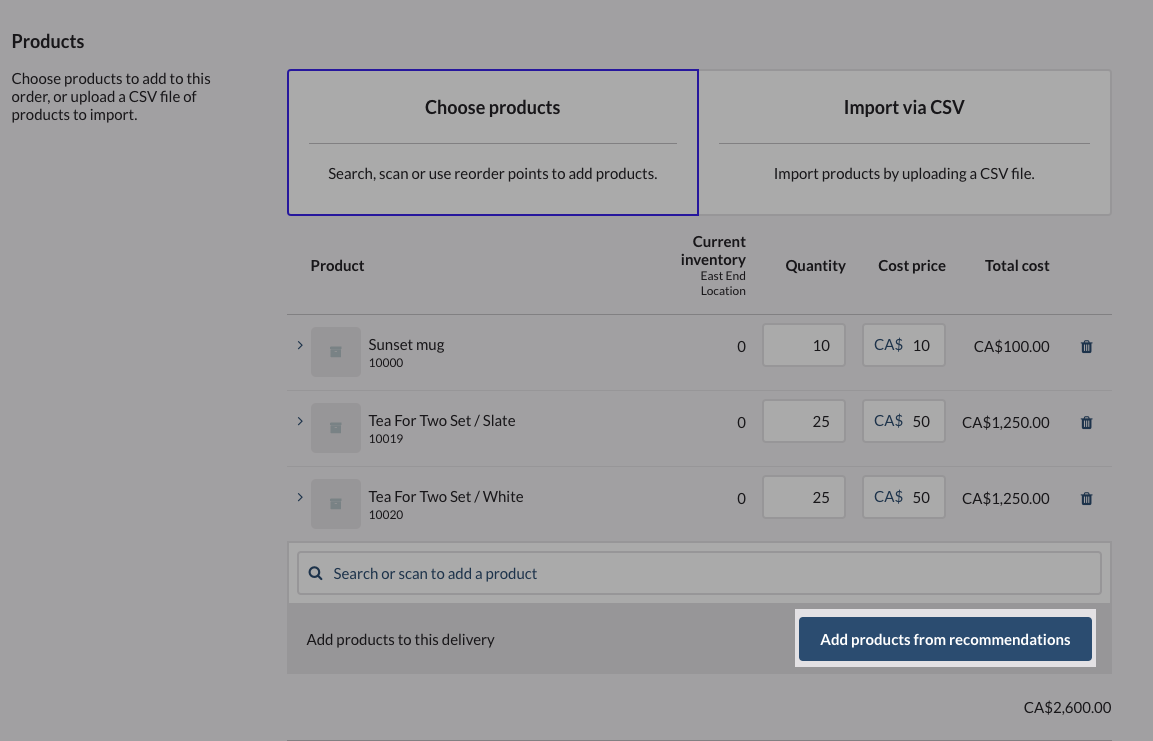
Dealing with dead stock can be a daunting issue for any retail business, posing significant financial burdens and logistical headaches. When products that have never been sold sit idle, they not only tie up capital but also occupy valuable storage space, which could be better utilized for more profitable inventory.
Thankfully, dead stock doesn’t need to be an inevitability. Addressing dead stock effectively is crucial for maintaining a healthy inventory turnover rate and ensuring the financial stability of a retail business.
To help you cut down on dead stock and keep your shelves healthy, we’ll go over:
Inventory Spreadsheet Template
Download this free inventory spreadsheet to help you better manage your stock, purchases and sales.

What is dead stock?
In retail, dead stock are products that have never been sold and are unlikely to ever be sold. This stock sits idly in inventory, consuming valuable space and tying up capital that could otherwise be used more productively. Dead stock slows cash flow, increases storage costs and lowers overall profitability.
Dead stock is a serious problem for retailers. Luxury retailers Burberry once burned $38 million in dead stock, having decided no sales were better than heavily discounted sales.
What’s the difference between dead stock vs. excess inventory?
Dead stock is not necessarily excess inventory. Excess inventory typically consists of items that are still sellable but have been over-ordered, and are likely to become slow-moving products that sell at a much slower rate than anticipated if not cleared out. Without intervention in the form of heavy discounts, dead stock isn’t going to sell at all.
Think of it this way: a fashion retailer might find themselves with dead stock in seasonal trends that have passed, excess inventory in popular sizes of a particular item and slow-moving products in niche accessories with limited demand.
What causes dead stock?
Dead stock arises from various factors, including overbuying due to inaccurate demand forecasting, changes in consumer trends rendering products undesirable, seasonal shifts where items become outdated and product obsolescence due to technological advancements.
Poor inventory management and lack of a responsive marketing strategy can exacerbate the issue, leaving retailers with stock that is difficult to sell.
Over ordering
Over ordering causes dead stock when you purchase more inventory than you can sell within a reasonable timeframe. This may be due to optimistic sales forecasts, failure to account for changing consumer preferences or misunderstanding market trends. For example, a retailer might over order winter coats based on previous years’ sales, not anticipating a mild winter forecast that reduces demand.
Over ordering is a major issue for retailers. In 2023, over a quarter of retailers were turning to secondary markets to offload excess inventory and dead stock clogging up supply chains.
You can avoid over-ordering by employing more accurate demand forecasting methods and analyzing sales data to understand consumer buying patterns.
Retail POS systems play a crucial role in preventing over ordering by offering detailed analytics and sales data that can be used to forecast demand. For example, Lightspeed Retail automatically calculates how many products you should order to keep your inventory at an optimal level.

Seasonal changes
Seasonal changes significantly influence consumer purchasing behavior, often leading to dead stock for retailers who fail to align their inventory with these shifts.
For instance, a home goods retailer might stock up on outdoor furniture and grilling accessories anticipating high demand during the spring and summer months, but find themselves with excess inventory as sales slow down into fall. Similarly, stores frequently overestimate the demand for holiday-specific items like Halloween costumes or Christmas decorations, resulting in unsold goods post-season.
Ordering practices that don’t account for historical sales data, current trends, and weather forecasts contribute to this problem.
POS analytics can mitigate the risk of accumulating dead stock from seasonal changes by offering insights into sales trends, customer demand and inventory turnover rates.
Changing consumer preferences
Changing consumer preferences can swiftly transform inventory into dead stock, especially in industries subject to trends and technological advancements.
Quickly fading fads, like specific toy crazes or fashion trends (such as fidget spinners or neon clothing), can lead to significant unsold inventory if retailers stock up anticipating sustained demand. Risky products that hinge on a particular event or celebrity endorsement may also become dead stock if the public interest wanes. Longer shifts in preferences, such as the move towards sustainable and eco-friendly products, can render traditional items obsolete.
To keep up with changing consumer preferences, retailers should:
- Engage with customers through surveys and feedback platforms to understand their evolving needs. While quantitative data—hard sales numbers—can help you predict upcoming shifts in demand, qualitative data from surveys can help tell the story as well.
- Adopt a flexible inventory management system that allows for quick adjustments to stock levels across locations.. Products that are dead stock at one store might sell well at another.
- Incorporate a just-in-time (JIT) ordering system to minimize excess inventory in case of sudden shifts in demand.
- Use POS system data to analyze sales trends and identify products that are declining in popularity, allowing for strategic discounting or promotional efforts to clear out impending dead stock before it becomes unsellable.
Identifying dead stock
To effectively monitor inventory levels and identify dead stock early, take advantage of inventory management software. It’ll help you track product movement, analyze sales trends and adjust inventory strategies accordingly.
Here’s how to best use inventory management software to identify dead stock:
- Conduct regular inventory audits: even with advanced software, periodic physical counts of inventory are crucial for verifying stock levels and identifying discrepancies early. These audits can uncover issues like theft, damage or misplacement that could contribute to dead stock.
- Embrace RFID technology: Radio Frequency Identification (RFID) tags can track individual products throughout the supply chain and store environment, providing detailed data on item movement and location. This technology helps retailers accurately monitor stock levels and product lifecycles.
- Use POS analytics: leverage the data from your POS system to track sales trends and customer preferences. Analyzing this data can reveal which items are moving slowly or at risk of becoming dead stock, allowing for timely promotional strategies or markdowns.
Above all else, data is your friend. With Lightspeed Advanced reporting, for example, you can run a dusty inventory report. The report will find all stock that hasn’t sold in a set period of time, so you spend less time trying to track down dead stock and can focus more on dealing with it.
What to do about dead stock
You don’t have to be resigned to dead stock weighing you down.
Implement best practices for inventory management to prevent overstocking and over ordering
Retailers can prevent overstocking by implementing best practices for inventory management, like utilizing cloud-based POS systems that enable real-time tracking of sales and inventory, offering valuable insights into product performance and customer preferences.
You should also:
- Leverage automated reordering systems: set up automated reordering points in your inventory management system to trigger reorders based on preset stock levels, preventing both excess inventory and stockouts.
- Conduct regular inventory counts: perform regular physical counts to verify inventory accuracy against your records, helping identify discrepancies and adjust purchasing strategies.
- Utilize JIT inventory: adopt a JIT inventory approach to receive goods only as they are needed in the production process, minimizing storage costs and reducing the risk of overstocking.
Don’t forget the importance of demand forecasting
Demand forecasting is pivotal in reducing dead stock. By accurately predicting future sales based on historical sales data, market trends, seasonal fluctuations and consumer behavior insights, you can align your inventory levels closely with actual demand.
Effective demand forecasting enables retailers to adjust their procurement strategies accordingly, ensuring that they order sufficient stock to satisfy customer demand while avoiding the accumulation of dead stock. This not only optimizes inventory management but also enhances cash flow and reduces storage costs.
If you’re not doing any demand forecasting, you can get started easier than you think. Consider tracking your business’ inventory turnover ratio as step one—it’ll help you assess the health of your inventory as a whole.
Establish a flexible return policy with suppliers
Okay, you’re counting inventory and you’re forecasting demand. You still end up with some dead stock, though. Now what?
Establishing a flexible return policy with suppliers is a strategic approach to mitigating those dead stock risks that slip through. By negotiating terms that allow for the return of unsold inventory within a certain timeframe, you can significantly reduce the financial burden of stock that doesn’t sell.
To facilitate this conversation with suppliers, emphasize the mutual benefits of such an agreement, including sustained business relationships and continuous order flow. It’s important to come prepared with sales data to demonstrate past inventory performance and to propose realistic return timelines and restocking fees that are fair to both parties.
Use pricing strategies like markdowns, sales promotions and clearance events to encourage sales
Stock that’s dead at full price might move at reduced prices. Markdowns, strategically timed, can incentivize customers to purchase items that are moving slowly, thus freeing up inventory space. You won’t get your full investment back, but it’s better than nothing, and you can use the revenue to purchase more strategically planned inventory.
Sales promotions, such as buy-one-get-one-free, limited-time offers or loyalty program discounts, can stimulate interest and urgency, driving both traffic and sales. Clearance events are particularly useful for seasonal or outdated items, making room for new stock while recovering some costs.
To maximize the impact of these strategies, analyze sales data to identify the optimal timing and discount levels. Promoting these offers through targeted marketing campaigns can also increase their visibility and effectiveness.
Consider bundling dead stock with popular items to increase attractiveness
Alright, the dead stock isn’t selling. But more popular items are. You could bundle them together, mark up the bundle for some fraction of the dead stock’s original price, and have the popular item help move things along.
For instance, a slow-selling accessory could be paired with a best-selling gadget at a combined price slightly lower than purchasing both separately. This creates a perceived value, encouraging customers to buy the bundle for the popular item while effectively moving the less desirable stock. Like with discounting, you might not get your full investment back, but you’ll have clear shelves and capital to put better moving products on.
To implement this effectively, identify complementary products that appeal to similar customer segments and ensure the bundle offers genuine value. Marketing the bundles creatively, highlighting the benefits or exclusive nature of the offer, can further entice customers.
Try upcycling or repurposing products to give them a new life
You can mitigate dead stock by upcycling or repurposing products, thereby catering to new markets with revitalized items. This approach involves creatively modifying unsold goods to meet different customer needs or trends, such as turning outdated clothing into reusable tote bags or repurposing old electronics for parts. These upcycled or modified products might sell better on an online marketplace, like Amazon or eBay.
However, it’s crucial to recognize when upcycling may not be worth the effort. Before you take this route, assess the potential for upcycling by considering the cost of transformation against the expected market value of the repurposed item.
If the cost of repurposing exceeds the potential selling price or if the target market for the repurposed product is too small or saturated, it’s likely not a feasible strategy. Additionally, products that are severely outdated or damaged beyond repair should be considered for recycling or ethical disposal instead.
Donate to charities for a tax deduction
Nothing’s working—now what?
You could contact a liquidator and use them to sell off your dead stock. Plenty of retailers do it, and it’s a pretty straightforward process. But you have another option: donating it.
You can convert dead stock into an opportunity by donating unsold items to charities, yielding both tax benefits and enhancing your brand image. This approach not only clears inventory space, but also contributes to social good, especially if you’re donating things like in demand seasonal clothing or outdated but still valuable electronics.
To facilitate this, select charities that align with your brand values and target market, ensuring that donated items are of use to the recipients. Documentation of donations is crucial for tax deduction purposes, so keep detailed records of the items donated, their condition and their fair market value. Make sure you consult with a tax professional to understand the specific tax benefits available and any legal obligations you have.
Don’t get weighed down by dead stock
Navigating dead stock is a challenge all retailers face, but it’s not insurmountable. With accurate demand forecasting, POS analytics and smarter ordering, retailers can significantly mitigate the risk of dead stock
The key to managing dead stock effectively lies in proactive inventory management and being adaptable to market changes. Don’t let dead stock drag you down—turn it into an opportunity to innovate and improve your business operations.
And make sure you have the best possible tools on your side to manage inventory. Lightspeed’s retail POS system makes ordering, organizing and selling stock a breeze—watch a demo and see for yourself.
FAQs
What is dead stock?
Dead stock refers to merchandise that has never been sold or used by customers, remaining in a retailer’s inventory for an extended period. It typically represents items that are out of season, outdated, or have been over-ordered and cannot be returned to the supplier.
Why is managing dead stock important for retailers?
Managing dead stock is crucial because it ties up capital that could otherwise be used for more profitable ventures. It also occupies valuable storage space and potentially incurs additional holding costs.
What can be done with dead stock?
Options for dealing with dead stock include discounting items for quick sale, donating to charities, recycling materials, or returning goods to suppliers if possible. Retailers might also explore opportunities to sell these items through alternative channels like outlet stores or online marketplaces.
Can technology help in managing dead stock?
Yes, technology plays a significant role in managing dead stock. Advanced inventory management systems like Lightspeed Retail help retailers forecast demand more accurately, optimize stock levels, and identify potential dead stock items before they become a significant issue.

News you care about. Tips you can use.
Everything your business needs to grow, delivered straight to your inbox.


